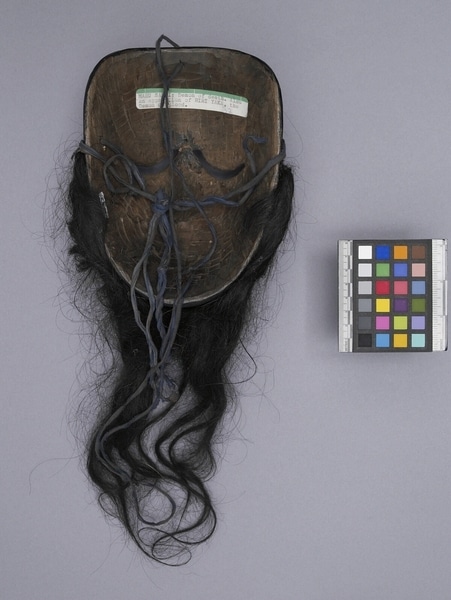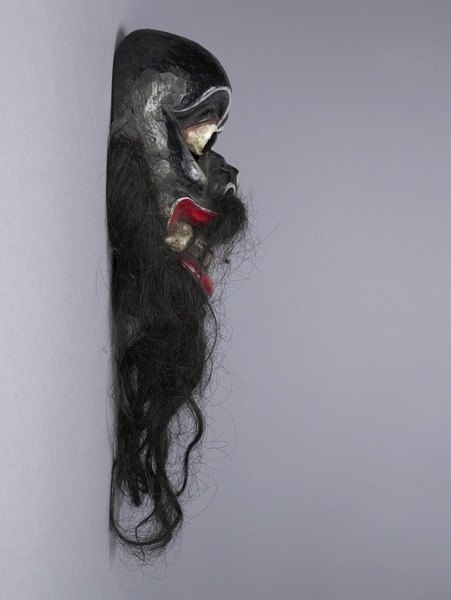Mask Item Number: Eh23 from the MOA: University of British Columbia




Description
Mask of male face representing Maru Sanniya, the deamon of death, and also Riri Yaka, the deamon of blood. The face has protruding eyes, thick red lips, large white teeth and fangs, a moustache, and a long, pointed beard. The nose is slightly squared, and the face is painted black overall with white used to outline wrinkles on the forehead, and to highlight the nose, cheeks and eye sockets. Crescent shaped openings are located at the lower rims of the eye sockets. A cord is threaded through two holes either side of the mask, and one in the forehead.
History Of Use
Worn during curing ritual of the Sanni Yakuma ceremony, part of the Tovil series of dramas performed by Sinhalese ritual specialists and dancers. The Sanni Yakuma is intended to combat diseases and afflictions caused by the Sanni group of demons. These consist of 18 or more apparitions of the chief demon, Maha-kola-sanni. The officiating healer honours Buddha, then appeases the demons with offerings, dancing, and chanting. The mask characterizes Riri Yaka, one of the many apparitions of Maru Sanni.
Iconographic Meaning
The mask represents 2 different identities: Maru Sanni at one stage of the dance; Riri Yaka at another. Both are considered demons with combined human, animal and supernatural features. Most facial features are humanlike; the snout is bear or monkey-like. The exaggerated, supernatural, bulging eyes and fangs, and the colours are demonic attributes. The two creatures belong to a group of 18 demons which symbolize and inflict various ailments. These Sanni Yakas have faces of disease-stricken men/demons. Their colours, including black or earth brown symbolize death. Maru Sanni, the demon of death associated with madness and delirium, is often seen as a bear, or with a beard or moustache. Riri Yaka is a monkey with an insatiable thirst for blood. He personifies disease with loss of blood. Both demons haunt deathbeds.
Cultural Context
exorcism
Item History
- Made in Sri Lanka before 1978
- Collected during 1978
- Owned by Jason Schoonover before February 10, 1981
- Received from Museum of Anthropology Shop Volunteers (Funding source) and Jason Schoonover (Seller) on February 10, 1981
What
Who
- Culture
- Sinhalese
- Previous Owner
- Jason Schoonover
- Received from
- Museum of Anthropology Shop Volunteers (Funding source) and Jason Schoonover (Seller)
Where
- Holding Institution
- MOA: University of British Columbia
- Made in
- Sri Lanka
When
- Creation Date
- before 1978
- Collection Date
- during 1978
- Ownership Date
- before February 10, 1981
- Acquisition Date
- on February 10, 1981
Other
- Condition
- good
- Current Location
- Case 107
- Accession Number
- 0704/0022